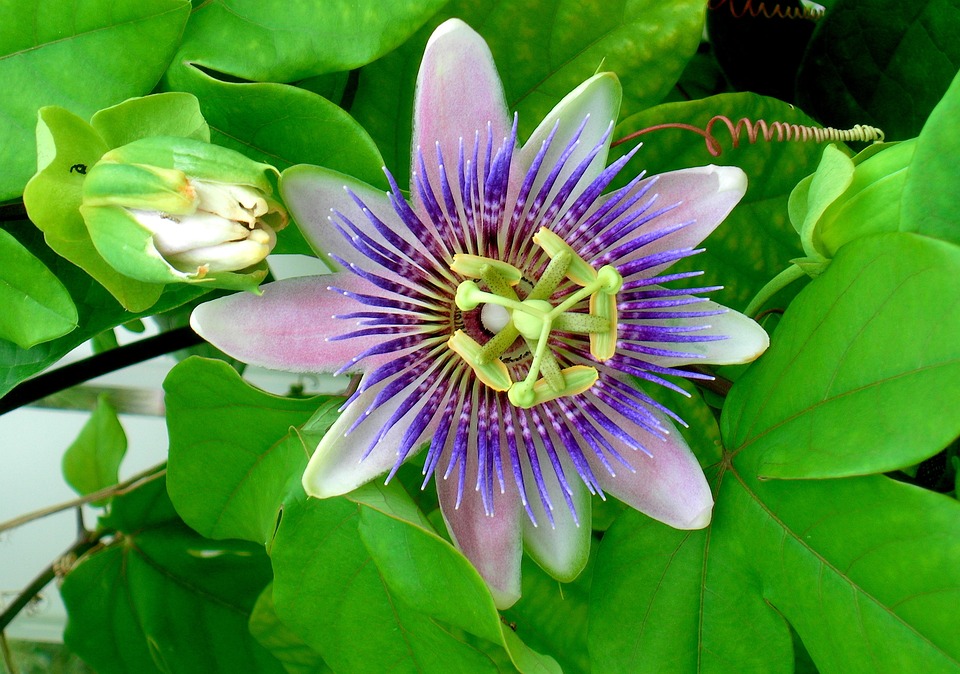 Sun Requirements
Sun Requirements
Full sun, with some afternoon shade in hot summer climates
Bloom Period and Seasonal Color
Most passion flowers repeat bloom from mid summer until fall
Mature Height x Spread
15 to 30 feet tall and 6 to 8 feet wide, depending on the variety
Passion flowers have a look and reputation for being exotic and hard to grow. However, this perennial vine is widely adapted in USDA zone 6 to 10 gardens, flowering from mid-summer until frost. Passion flowers are also called passion vines because of their growth. But there are some passion flowers that are more like shrubs than vines. Some passion flower produce edible fruits as well.
The exotic, fragrant flowers on all passion flowers are open for only one day. But the flowers are so complex, colorful and stunning that it’s always a delight even if you only get a few flowers per vine.
The climbing vine attaches itself to structure, wire and string with tendrils making this a good plant for pergolas, trellises and fences.
When, Where and How to Plant
Plant passion flowers in spring on fertile, well-drained soil. Although you can start passion flowers from seed or cuttings from a friend, it’s easiest to purchase plants fro ma nursery.
Plant vines in a hole dug three times the diameter of the root ball. Remove the plant from the pot and wash off the potting soil revealing the root system. Prune off any circling or errant roots and plant, add water and the native soil to the hole. Keep passion flowers well watered.
Passion flowers can also be grown in containers, especially in cold areas. Bring them outdoors in summer into a sunny, warm spot. Overwinter the plants indoors in a sunny window. With some luck you’ll get flowers forming in late summer.
Growing Tips
Passion flowers can be rampant growers. In fact, in some areas of the South they are considered invasive. Plant where their size can be maintained with annual pruning or grow them in containers. Even in marginal areas, such as USDA zone 6, where passion flower may dieback to the ground each winter, they will grow back from their root system in spring and flower that late summer.
Grow passion flowers in full sun, on well-drained soil and fertilize in spring and mid-summer to get the best growth and blooms. Keep the soil moist with mulch. The mulch also can protect the roots in winter in cold areas.
Plant Care
Passion flowers usually don’t need much attention to deadheading and pruning. You can remove spent flowers to keep the plant tidy and pruning should be done in early spring to keep an aggressive plant in bounds.
In areas where passion flowers thrive, so do their pests. Control aphids, white flies and spider mites with sprays of insecticidal soap whenever you see damage. Clean up dropped leaves in fall to reduce fungal diseases on the flowers and foliage.
Companion Planting and Design
Grow passion flowers vines up trellises as a focal point in your landscape. Passion flowers dazzle when grown in entry way gardens or in front door areas. Passion flowers pair well with other butterfly attracting plants such as butterfly bush, butterfly weed, pentas and Joe Pye weed. The butterflies enjoy the exotic flowers as much as we do.
Varieties
There are many newer hybrid passion flowers available for home gardeners. ‘Sunburst’ features orange and yellow flowers. ‘Inspiration’ has deep purple colored flowers. ‘Raspberry Strudel’ has various shade of pink and red in its blooms. ‘Lady Margaret’ is a red variety. ‘Victoria’ is a pink flowered, evergreen vine in warm climates.
Passiflora edulis produces small purple or yellow colored, edible fruits after flowering. Passiflora incarnata is a native deciduous vine in the Southeast. It grows close to the ground and when you step on the fruits they pop, hence the common name Maypop.


